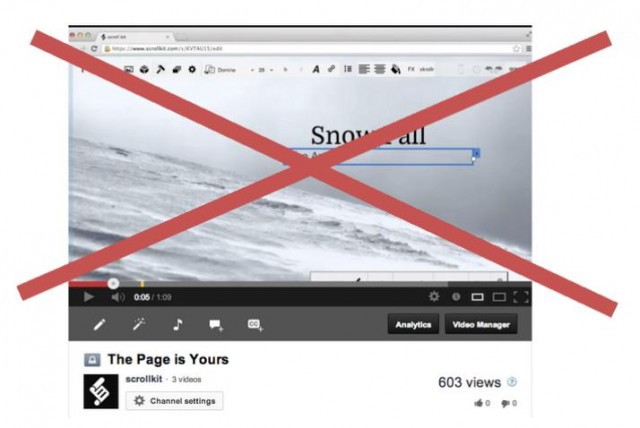Everyone Secretly Hates "Snow Fall"

Cody Brown, of Scrollkit, made a replica of the ballyhooed New York Times “Snow Fall” story — in about an hour. Naturally, the Times made a copyright complaint: he was, after all, using their images and whatnot! So he removed it. Then they insisted that he “remove any reference to the New York Times” from his website. Heh.
He writes:
The backlash to “Snow Fall” is that it’s an indulgence only the Times can afford. It took them six months and a powerful multi-person dev team to hand-code it. Most news orgs don’t have anywhere near these kinds of resources, and this is why we’ve spent the past year creating a tool that opens the ability to produce these stories to significantly more people.
This is a good point, even though we should note that it’s in service of promoting his company, and it’s not something many people want to say in public. (Update: We want to be clear that, yeah, there was not actually SIX MONTHS of coding. That’s way over the top.) Privately, the kvetching about Snow Fall among “media people” has been pretty intense. Each time this topic comes up around journalism profs or reporters, there’s a huge amount of eye-rolling. That eye-rolling is always, however, as it should be, preceded by praise: it was great work, it needed to be done, all that jazz. Everyone appreciates the labor; they just don’t think it changes everything. There’s generally five ideas people bring up.
Their points generally are:
• Although it was an exceedingly well-reported story that lent itself well to lovely web expression, the story itself was not particularly newsworthy, or recent, or ground-breaking, or exclusive.
• During the story’s construction, it became a situation where it seemed — at least from the outside — like the form began to demand unreasonable length of the content.
• It was a monetary sinkhole: while the coding seems spectacular (and it didn’t destroy browsers, unlike recent efforts by Pitchfork), the sheer person-hours devoted to it were financially untenable.
• The obvious lack of involvement of the sales team at the paper was incredibly short-sighted.
• With an average of 12 minutes on site for its visitors (which is to be fair very, very long!), there’s still no way most visitors actually read that story. They came for spectacle.
The off-record beefing about Snow Fall in many ways isn’t even Snow Fall’s fault! It’s the hubbub that surrounded it after — all the Snow Fall will save media baloney. We all like Snow Fall, we’re just tired of having to hear about it at conference after conference and panel after panel. Besides: not made like that it won’t “save journalism.” No way.
It’s a shame that the Snow Fall model eclipsed the Nate Silver model in the imagination of the “future of journalism” crowd. In early 2012, 1% of Times readers were reading Nate Silver; as the election drew near, on a single day, 20% of Times readers came to read Nate. Using traffic from September of 2012, the Times was doing about 8 to 9 million people a day overall, in Comscore numbers (so: vastly undercounted probably, and as the election drew near, traffic surely increased).
So Nate Silver basically did Snow Fall-level traffic in just a single day. As cyclical as politics traffic obviously is, that’s still a much better future of journalism — and a much better use of budget.
